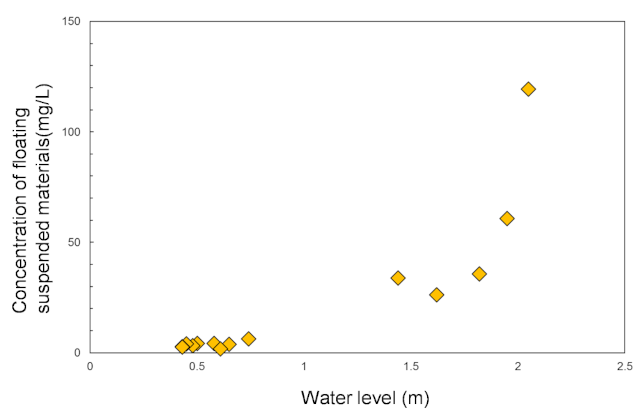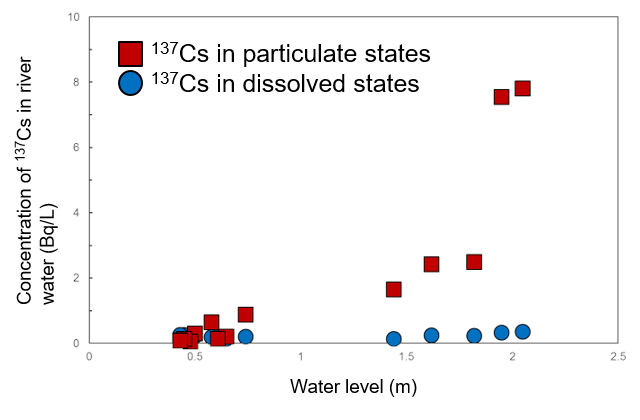Radioactivity Dynamics in River System
(2015)
QDoes the concentration of radioactive cesium in river water increase after rainfall? 【Changes of the concentration of 137Cs in heavy rain】
AAfter heavy rain, the concentration of radioactive cesium in the particulate state increases together with an increase in the amount of sediment particles in river water.
- Investigations of rivers in Fukushima Prefecture have revealed that most cesium exists in the dissolved state in clear water with low flow rates. Since 2012, the concentration of radioactive cesium in these regions has been lower than the detection limit of radiation detectors (about 1 Bq/L).*1
- When the flow rate of a river increases, the concentration of floating suspended materials increases. Radioactive cesium is strongly adsorbed on such suspended matter (particulate state). For that reason, when the water level is high, the concentration of cesium in the particulate state increases, while that in dissolved states does not change so much.
- Investigations of the Ukedo River, Fukushima Prefecture have revealed that the concentration of radioactive cesium is lower than the maximum value for drinking water (10 Bq/L) even when the water level is high.
-

Fig.1 Relationship between flow rate (water level) and concentration of floating suspended materials in the downstream Ukedo River (near Ukedo Bridge) (2014-2015)
-

Fig.2 Relationship between flow rate (water level) and concentration of 137Cs in the downstream Ukedo River (near Ukedo Bridge) (2014-2015)
Reference:*1 Report on the Project for the Nuclear Regulatory Agency, “Data Accumulation for Distribution of Radioactive Materials Released from Fukushima Daiichi Nuclear Power Station, TEPCO and Development of Migration Model” (FY 2014).
Related articles
- Does the concentration of radioactive cesium in river water increase after rainfall? 【Effect of the upstream dam on the 137Cs concentration】
- How do rainfalls affect turbidity and radioactive cesium concentrations in river water? 【Example of analysis】
- When it rains, does radioactive cesium flow out of forests with soil? 【137Cs flow in heavy rain】
- When it rains, does radioactive cesium flow out of forests with soil? 【137Cs flow from river basins and mountain slope】
- How much did the amount or the concentration of Cs released to river water by forest fire? How did them change by time?
